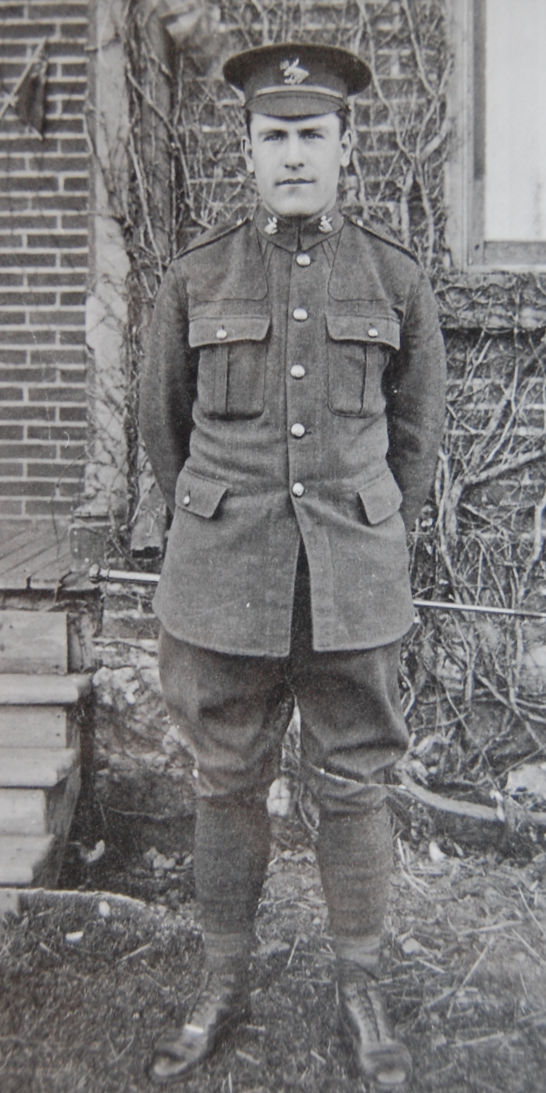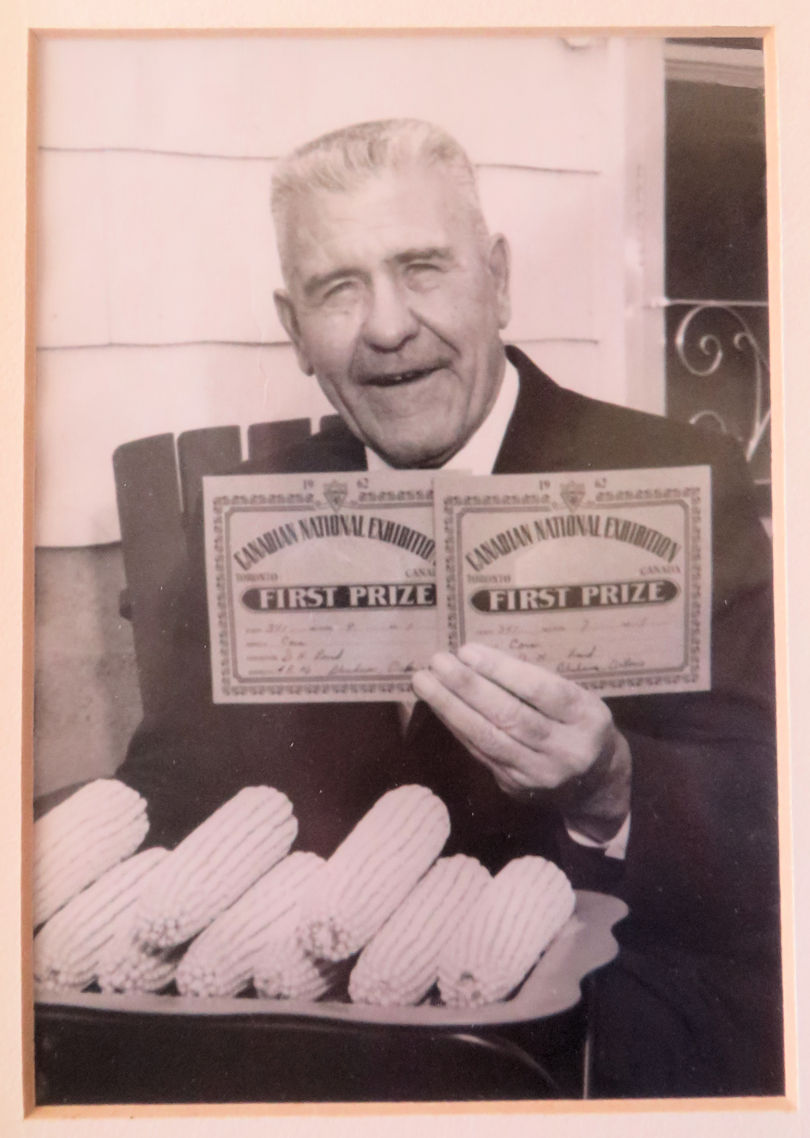
112079 Pte. Donald Harry Laird, "Harry" to his family and friends, was born on 23rd August 1893, in Blemheim, Ontario to Archibald and Hannah Laird. Harry was one of four known children, having siblings in Archie (b1890), Jean (b1892) and Thomas (b1897). Archie was an E.N.T. (ear, nose, throat) physician, serving as such as a Captain in the R.A.M.C. in WW1, having signed on in London, Ontario in March 1918. Jean served as a nurse, whilst Thomas joined the R.A.F. One can only try to imagine what it felt like for parents Archibald and Hannah to see their four children all go off to war.
The Laird family arrived in Blenheim in 1842, long before it was officially a town. Blenheim is in Kent County, in the township of Harwich, Ontario. The Laird farm was a very large acreage for the time, at of over 350 acres. It is considerably smaller now than it was at its height, but it is still owned by the family. Harry worked on the farm with his brothers and father, and his particular speciality was corn and tobacco. He worked the land with a single furrow plough and a pair of horses. Just before the war, he attended the Canada Business College in Chatham, Ontario (about 10 miles / 16km from Blenheim), and he was looking for some excitement when WWI broke out. He found it!
When the call came in November 1914, Harry was a single man. He signed on in London, Ontario, on 15th January 1915, initially being assigned to the 2nd Canadian Divisional Cavalry, and was later one of 23 men of what was by then known as the 7th CMR, who were transferred to the 4th CMR on 21st October 1915.
Harry arrived in France on 24th October 1915 with the 4th CMR. His service file notes that on 29th October 1915 he forfeited 1 day's pay for absence, and on 24th December 1915, underwent 1 day of Field Punishment No.1 (shackled or tied to a gun carriage wheel or fence post for up to two hours per day), for failing to comply with a Regimental Order concerning shaving.
Being assigned to 'C' company, Harry was in the left of front line trenches 47-53, Armagh Wood, Mount Sorrel, southeast of Ypres, on 2nd June 1916, when the 'Battle for Mount Sorrel' was opened by the Germans. The CMR front there was subjected to 5 hours of relentless pounding by shells and high explosives, from 8am until 1pm, whereupon two mines were exploded under the Battalion's front line position. German troops swarmed across the now flattened terrain, taking prisoners of those wounded and those isolated or otherwise trapped underground in blown-in dugouts.
In all, that morning, 350 men of the 4th CMR were taken POW, whilst 193 were killed outright. Just under 80 men answered to their names the following morning. Indeed, it is worthy of note that the highest ranking officer killed in World War One, Major-General Malcolm Mercer, was lost on this day while inspecting troops in the area.
Having survived the first two brutal hours of the bombardment, albeit in taking minor shrapnel wounds from the continuous heavy shelling, Harry and two comrades endeavoured to retire to safer positions through ground that offered no protection or cover whatsoever. Heavily buffeted by constant explosions all about them, a shell landed very close to Harry, wounding him in five places in the left leg and hip. The explosion killed one comrade, seriously wounded the other and partly buried Harry's legs. He lost consciousness for a while and when he came to the shelling was still raging on around him. It felt like a hopeless situation and Harry was welcoming the end. With so much blood lost, he began to slip back into semi-consciousness when quite miraculously a selfless, devoted and subsequently unknown medic appeared at his side out of the maelstrom of death and destruction, dressed his wounds and then moved on, never to be seen again.
For four hours Harry lay wounded out in the field as the battle raged on. Slipping in and out of consciousness as hallucinations gripped him, he came to just before the end of the onslaught, and was lucid enough to witness one of the mines that went off far enough away from where he lay that he survived that too!
Harry told grandson Bruce Warwick that he watched the Germans walking over whilst he lay on the ground in his wounded condition. They passed from prone soldier to soldier bayoneting them. Harry said a German soldier then laid a bayonet on his chest, the two soldiers fixed eyes, and for whatever reason, the German raised his bayonet and called for a stretcher. It was that close to death.
Then began Harry's 15 months of life as a wounded POW.
The story from here is fully expanded upon in Harry's book, 'Prisoner 5-1-11', written in 1919. The book can still be tracked down out there, having been republished by Norm Christie through CEF Books in 2006. You are strongly encouraged to read it, as it presents a full and unyielding account of life as a prisoner of war in WW1.
The book is currently available in Canada through Battlefield.ca, and variously on eBay around the world.
Treated and held in a number of prisoner camps in St Minin, Aachen, Stuttgart and Stendal, and latterly recovering in a Swiss hospital before repatriation, a little under a year and a half after capture, Harry was amongst those included in the first prisoner exchange of the war. He returned to England in mid-September 1917. From there he returned to Blenheim, Ontario, and was formally struck off strength from the 4th CMR on 26th January 1918 as medically unfit to continue in service; a matter that was decided for him anyway as a condition of his exchange and repatriation - he would have been unable to return to service even if fit.
Bruce adds that it was amazing that the surgeon who operated on Harry right after he was first wounded, Dr Oskar Weisenbohlar, returned Harry's bible to him after the war. Bruce has that same bible that Harry carried. Harry had said the surgeon was very kind to him. He remembers straight iodine being poured into his wounds, particularly his large leg wound.
Back in civilian life, Harry married music teacher Isabel Austen Betts in Harwich township, Kent County, Ontario on 11th February 1920. The couple had two children. Archie born in 1924 and graduated from Wayne State University with a degree in Aeronautical Engineering, and served in WW II, based principally in Belgium. He passed away in 1996. A second child, Isabel, was born in 1927. She worked as a book keeper and as a commercial pilot.

Harry Laird was well known in the Blenheim / Harwich area as a successful farmer who, among his other attributes, continues to hold the record to this day at the Royal Agricultural Fair in Toronto for successfully winning First Place from 1920 to 1967 with his submissions of White Flint and Hybrid Dent class corn. No other farmer in Ontario has achieved this level of success before or since. Harry also won first place positions at the Chicago International Hay and Grain Show, the London Agricultural Fair, and the Chicago Exhibition. There's only one First Place position at any exhibit, and Harry was the successful candidate every year (as seen, right, at the Canadian National Exhibition in Toronto in 1962). It is little wonder that the newspapers referred to him as the "Corn King".
After suffering a heart attack in the early 1960's, Harry retired from active farming and maintained a small garden which included his beloved Flint and Dent corn for contest purposes. He accepted a job from the Warwick Seed Company, and successfully sold seed corn to his neighbours and farming friends. He was well respected and trusted by his peers. Harry was a member of the Presbyterian Church and sang in their choir. He served as a life member of the Blenheim Legion Branch #185 serving as president in 1942 and 1943, and his picture currently hangs in the Legion Hall. Harry also played trombone in a local band called the Jazzy Cats in Blenheim for various town functions. Harry was also a trustee of Samson's School for many years, the same public school he had graduated from many years before.
His daughter Isabel recalls as a small child (circa 1935-ish), that the large "healed" wound in Harry's leg would discharge when Harry was ploughing and walking behind the horses. Antibiotics, like penicillin, were not invented until the late 1930s! His hand had the middle finger permanently bent to 90 degrees, and Bruce recalls that they could feel shrapnel pieces in his arms. He always walked with a pronounced limp.
Harry latterly passed away from heart failure on 31st May 1969 in Bleheim, in his beloved garden on the Laird Farm, aged 75. Many years before, his father had donated land to the Town of Blenheim to form a cemetery called Evergreen Cemetery. Harry lies at rest in that very cemetery, on Talbot Street East, in Blenheim, Ontario.
Credit and many thanks go to Harry's grandson Bruce Warwick for the above biography and images.
Additional service details provided by 4cmr.com